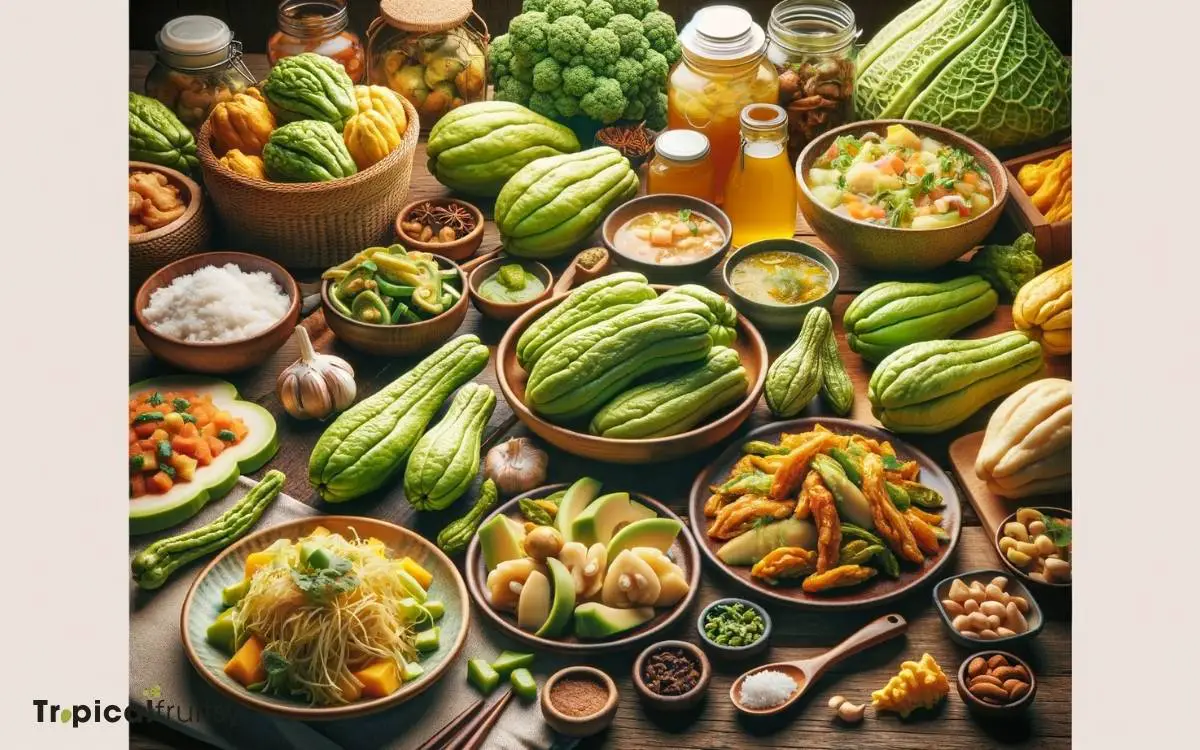What Is Chayote Used for? Maximize Your Health!
Chayote, also known as mirliton, is primarily used as a versatile culinary ingredient. It is prized for its mild taste and crisp texture, which makes it suitable for a variety of dishes.
Due to its high nutrient content, including vitamins C and B6 and dietary fiber, chayote contributes to a healthy diet. It can be enjoyed both raw and cooked, with common preparations including salads, soups, stews, and as a stuffed vegetable.
Chayote’s adaptability also extends to its use as a meat substitute in plant-based recipes and as a pickled condiment. Chayote is a gourd that offers culinary flexibility due to its neutral flavor and satisfying crunch.
Here are some of the ways chayote can be used:
Chayote’s versatility extends from fresh salads to hearty stews, proving to be a culinary chameleon in kitchens worldwide.

Key Takeaway
Chayote Preparation and Uses – A Versatile Gourd in the Kitchen
| Preparation Method | Description | Common Uses |
|---|---|---|
| Raw | Sliced or diced, served fresh | Salads, slaws, garnishes |
| Sautéed | Cooked in a pan with little oil | Side dishes, fillings for tacos |
| Roasted | Cooked in an oven until tender | Side dishes, blended into purees |
| Boiled/Steamed | Cooked in water or steam until soft | Soups, stews, mashed as a side |
| Stuffed | Hollowed out and filled with stuffing | Baked as a main course |
| Meat Substitute | Used in place of meat for texture and substance | Vegan and vegetarian dishes |
| Pickled | Preserved in a vinegar solution | Condiments, added to sandwiches |
Understanding Chayote Basics
Chayote, a pear-shaped gourd, serves as a versatile culinary ingredient with origins in Mesoamerica. Known scientifically as Sechium edule, it is part of the Cucurbitaceae family, which includes cucumbers, melons, and squash.
Chayote’s mild flavor and crisp texture make it suitable for a wide range of dishes, from salads to soups, and it is often used as a low-calorie substitute for starchy vegetables. Rich in vitamin C, B vitamins, and trace minerals, chayote also offers various health benefits.
It can be eaten raw or cooked, and its seed, skin, and even the vine tendrils are edible, highlighting its resourcefulness in culinary applications. Understanding these basics is crucial for appreciating the full potential of chayote in gastronomy.
Nutritional Benefits Explored
Beyond its culinary versatility, chayote provides numerous health advantages, containing a significant array of essential nutrients including vitamins, minerals, and dietary fiber.
This low-calorie vegetable is a smart choice for those seeking to maintain a healthy diet, while still enjoying a variety of food options.
The nutritional profile of chayote boasts a range of benefits that can contribute to overall health and well-being.
- Vitamin C: Supports immune function and skin health.
- Folate (Vitamin B9): Important for cell growth and the formation of DNA.
- Fiber: Aids in digestion and can help regulate blood sugar levels.
- Magnesium: Essential for muscle and nerve function, and bone health.
- Potassium: Helps maintain healthy blood pressure and cardiovascular health.
Raw Consumption Ideas
Salads and slaws often feature chayote as a crisp, refreshing ingredient, offering a unique texture and a subtle, slightly sweet taste that enhances raw dishes.
When consumed raw, chayote can be julienned or sliced thinly to complement greens or other vegetables. Its hydrating properties and mild flavor make it perfect for summer salads or as a crunchy addition to wraps.
Moreover, chayote can be chopped and added to salsas or ceviches, providing a delightful contrast to the acidic components. For a quick, nutritious snack, chayote sticks can be dipped in hummus or a yogurt-based dip.
Health enthusiasts appreciate chayote’s low-calorie profile and its contribution of vitamins and minerals to a balanced diet while enjoying its versatility in raw preparations.
Cooking With Chayote
Transitioning from its raw applications, chayote also exhibits remarkable versatility when cooked, serving as a nutritious addition to a myriad of culinary creations ranging from savory stews to baked dishes.
Its subtle flavor and crisp texture make it an excellent canvas for absorbing spices and seasonings, enhancing the overall taste profile of the dish.
When cooked, chayote becomes tender, making it a delightful ingredient in sautéed vegetable medleys, where it can be seasoned with herbs and spices. It also contributes a mild squash-like flavor to hearty soups and broths.
In stir-fries, chayote pairs well with meats and other vegetables. It can also be used in stuffed chayote recipes, filled with cheese, grains, or other proteins. Additionally, chayote adds moisture and a tender texture to casseroles and gratins.
Chayote’s culinary flexibility makes it a valuable and healthful component in diverse cooking traditions.
Chayote in Soups and Stews
Chayote, a versatile squash, is a notable addition to soups and stews, offering a subtle flavor that complements a wide range of ingredients.
Its firm texture holds up well during cooking, providing a satisfying bite that enhances the heartiness of these dishes.
Moreover, chayote’s inclusion boosts the nutritional profile, contributing essential vitamins and minerals to every spoonful.
Flavor Enhancement
In many culinary traditions, one chayote squash can significantly enhance the flavor profile of soups and stews with its mild and slightly sweet taste.
The unique flavor of chayote makes it an excellent addition to various dishes, subtly complementing other ingredients without overwhelming them.
- Complements Proteins: Chayote pairs well with chicken, beef, and seafood, absorbing and melding with their flavors.
- Vegetable Medleys: Adds depth to vegetable soups and stews alongside carrots, potatoes, and celery.
- Herbal Infusion: Harmonizes with herbs like cilantro, thyme, and bay leaves.
- Cultural Versatility: Features in Latin American, Asian, and Creole cuisines.
- Broth Integration: Soaks up the essence of broths and stocks for a richer taste experience.
This squash not only enriches the taste but also contributes to the overall mouthfeel, leading us to consider its texture contributions in the following section.
Texture Contributions
Beyond its role in flavor enhancement, chayote contributes a distinct texture to soups and stews through its firm yet tender consistency.
When cooked, chayote maintains a satisfying crunch that adds depth to the overall mouthfeel of such dishes. This is particularly valuable in long-simmered recipes where other vegetables might turn mushy.
The chayote’s resilient texture holds up well, providing a pleasant contrast to softer ingredients.
Additionally, its ability to absorb flavors enriches the dish without overshadowing other components.
Chefs and home cooks alike appreciate chayote for its versatility and its capacity to introduce a refreshing bite to an array of comfort foods, ensuring that each spoonful is as engaging as it is nourishing.
Nutritional Benefits
One often overlooks the nutritional benefits of incorporating chayote into soups and stews, despite its substantial contributions to a balanced diet.
This versatile vegetable offers an array of health advantages, making it a valuable addition to any meal, especially in the form of comforting soups and hearty stews.
- Low in Calories: Chayote is a low-calorie food, making it ideal for weight management.
- Rich in Fiber: It contributes to digestive health and can help regulate blood sugar levels.
- Vitamin C: Aids in immune system function and has antioxidant properties.
- Minerals: Contains essential minerals like potassium and manganese, which are important for heart health and metabolism.
- Hydration: High water content helps maintain hydration and adds volume to meals without significant calories.
Salads and Slaws Variations
Chayote’s crispness lends a refreshing bite to salads and slaws, making it a favored ingredient for those seeking a textural contrast in their dishes.
Its subtle flavor harmonizes with a myriad of other ingredients, allowing it to pair seamlessly with various fruits, vegetables, and proteins.
Moreover, chayote’s flesh is particularly adept at soaking up dressings, ensuring that each bite is infused with the intended flavors of the salad or slaw.
Crunchy Texture Addition
The versatile chayote squash contributes a delightful crunch to salads and slaws, enhancing their texture and refreshing quality.
When diced or julienned, chayote is an excellent addition that complements various ingredients without overwhelming them.
Its subtle flavor and crispness offer a unique alternative to more traditional salad ingredients like cucumbers or celery.
- Raw Integration: Chayote can be sliced thinly for a raw, crisp addition to garden salads.
- Slaw Component: Grated or julienned chayote adds volume and crunch to slaws.
- Marinated Mix-Ins: Chayote absorbs dressings well, making it ideal for marinated salads.
- Nutrient Boost: Incorporating chayote into salads increases the dish’s vitamin and mineral content.
- Creative Contrast: Pair chayote with softer elements like avocado or roasted nuts for textural diversity.
Flavor Pairing Options
In exploring its culinary uses, chayote’s mild flavor makes it an ideal candidate for pairing with a wide array of dressings and ingredients in salads and slaws.
The vegetable’s subtle taste absorbs and complements stronger flavors, such as citrusy dressings, herby vinaigrettes, or creamy mayonnaise-based sauces.
Chayote’s crispness adds a refreshing bite to leafy greens or cabbage mixtures, while its tenderness when cooked can soften more robust greens like kale.
It pairs beautifully with ingredients like toasted nuts for a nutty crunch, sweet fruits for a balance of flavors, or aromatic herbs for a burst of freshness.
Chefs often incorporate chayote into slaws with carrots, radishes, and a hint of lime to create a vibrant, healthful, and flavorful dish.
Dressing Absorption Qualities
One remarkable quality of chayote is its ability to absorb and enhance the flavors of dressings, making it a versatile ingredient in various salad and slaw recipes.
When incorporated into these dishes, chayote’s sponge-like texture allows it to soak up vinaigrettes and marinades, which not only adds depth to the dish but also ensures that every bite is infused with the intended flavors.
This characteristic makes it particularly popular in culinary practices that value the balance and harmony of flavors.
- Texture: Chayote’s crispness adds a refreshing bite to salads and slaws.
- Flavor Carrier: It acts as a conduit for the dressing, enhancing the overall taste.
- Nutrition: Chayote contributes vitamins and fiber without overpowering other ingredients.
- Variety: Works well with both creamy and vinaigrette-based dressings.
- Culinary Fusion: Adapts easily to different cuisine styles, from Asian to Latin American.
Stuffed Chayote Creations
Stuffed chayote creations showcase the vegetable’s versatility as a vessel for a variety of flavorful fillings, ranging from meats and cheeses to grains and vegetables.
The chayote’s mild flavor and firm texture make it an excellent container that complements an array of ingredients and spices.
It can be baked, steamed, or sautéed to create a unique, nutritious dish that pleases both the eye and the palate.
| Filling Category | Example Ingredients | Preparation Style |
|---|---|---|
| Meat & Seafood | Ground beef, shrimp | Baked & gratinéed |
| Vegetarian | Quinoa, black beans | Steamed & seasoned |
| Cheese | Ricotta, mozzarella | Sautéed & melted |
These combinations allow for a symphony of tastes and textures, catering to diverse dietary preferences and culinary creativity.
Chayote as a Meat Substitute
How does chayote serve as a meat substitute in vegetarian and vegan cuisine?
With its mild flavor and meaty texture when cooked, chayote is an adaptable ingredient that can mimic the role of meat in various dishes. It absorbs seasonings and spices well, making it an ideal canvas for culinary creativity.
Here are some of the ways chayote can be used as a meat substitute:
- Textural Mimicry: Its firmness resembles that of cooked chicken or pork.
- Flavor Absorption: Chayote takes on the flavors of accompanying ingredients.
- Nutritional Profile: Offers fiber and essential vitamins with low calories.
- Versatility: Can be sautéed, grilled, baked, or stewed.
- Visual Appeal: When sliced or diced, chayote’s appearance complements a range of recipes.
Incorporating chayote as a meat substitute can enrich a plant-based diet with new textures and flavors.
Preserving and Pickling Chayote
Transitioning from its role as a meat substitute, chayote can also be preserved through pickling, offering a tangy addition to salads, sandwiches, and antipasto platters.
The process of pickling chayote is straightforward yet yields a remarkably versatile condiment.
Typically, slices or cubes of chayote are immersed in a mixture of vinegar, water, salt, and an array of spices such as mustard seeds, garlic, and chili pepper for a piquant kick.
Over time, the acidic brine infuses the chayote with a balanced sourness, enhancing its natural crispness.
This preservation method not only extends the chayote’s shelf life but also transforms it into a delightful, zesty garnish that complements a myriad of dishes, adding depth and excitement to the palate.
Conclusion
Chayote is a versatile vegetable that contributes significantly to dietary diversity and nutrition. It can be consumed raw, cooked, or preserved, catering to a range of culinary preferences.
An interesting statistic reveals that in certain regions, chayote production has increased by over 30% in the past decade, reflecting its growing popularity and recognition of its health benefits.
This surge underscores the importance of chayote in global diets and its potential for culinary innovation.






